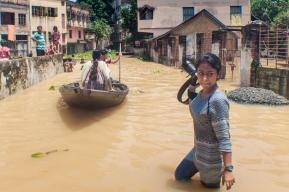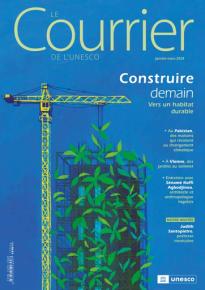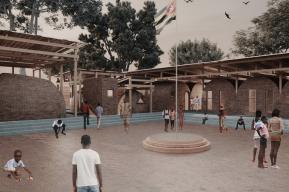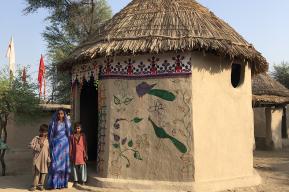فكرة
أفريقيا: الاندفاع نحو الذّهب الأزرق

أصبح عدد متزايد من البلدان الأفريقية يعتبر استغلال الأنشطة المرتبطة بالبحار قطاعا استراتيجيا بإمكانه أن يتحوّل إلى رافعة هامّة للتنمية في غضون السنوات المقبلة، وذلك شريطة تعزيز مكافحة التداعيات الناجمة عن تغير المناخ والإفراط في صيد الأسماك.
آدم عبده حسن
أستاذ باحث في جامعة روان (فرنسا) والمدير التنفيذي للمعهد النيجيري للدراسات الاستراتيجية والدولية INESI.
أصبح الاقتصاد الأزرق، في نظر الاتحاد الأفريقي، بمثابة "أفق جديد للنهضة في أفريقيا". ففي أجندة التنمية المستدامة لعام 2063، التي تضبط المبادئ التوجيهية الاستراتيجية للسنوات المقبلة، أعلنت هذه المنظمة أن الاقتصاد الأزرق يشكل أحد "الأهداف والمجالات ذات الأولوية للسنوات العشر القادمة". هذا، ويُعتبر الدليل العملي الصّادر عن اللجنة الاقتصادية لأفريقيا التابعة للأمم المتحدة في مارس 2016 في شأن الاقتصاد الأزرق، مؤشّرا على الاهتمام الذي يُحظى به هذا القطاع.
والاقتصاد الأزرق، الذي لا يزال غير معروف على نطاق واسع، بإمكانه أن يشكل دعامة قويّة للتنمية في القارة الأفريقية. وقد خطت بعض البلدان، مثل السيشيل، هذه الخطوة، فعليا، بإدماج الاقتصاد الأزرق في خطتها التنموية. في حين أطلقت جنوب أفريقيا، عام 2014، مشروع عملية فاكيزا (بمعنى "حثّ الخُطى" باللّغة السّوتيّة) لاستغلال الإمكانات الاقتصادية الكامنة للمحيط من خلال أنشطة النّقل والصناعة البحرية، والتنقيب عن النفط والغاز في البحار، وتربية الأحياء المائية. وفي غرب أفريقيا، اعتمدت بلدان، مثل التوغو والسنغال، استراتيجيات ترمي إلى إرساء اقتصاد أزرق مستدام.
ولا بد من القول أنّ الآفاق واعدة بالنسبة إلى قارة تضم 54 دولة من بينها 38 بلداً ساحلياً وجزيرياً تمتد مياهها الإقليمية على 13 مليون كم². فضلاً على أنّ أكثر من 90% من الواردات والصادرات الأفريقية تتم عن طريق البحر.
إمداد حيوي بالبروتينات في مجال التغذية
بإمكان الموارد المتأتية من البحر معالجة المسألة الغذائية والأمن الغذائي لما يقارب المائتي مليون مواطن أفريقي من خلال الإسهام الحيوي الذي يمكن أن توفّره الأسماك البحرية وأسماك المياه العذبة. ففي البلدان التي تشكو عجز غذائيا أو دخلا منخفضا، تسهم المصادر السّمكية بنحو 20% من البروتين الحيواني، في حين تصل هذه النسبة إلى 50% في البلدان الجزيرية أو السّاحلية ذات الكثافة السكانية العالية مثل غانا وغينيا والسنغال. فالرّهان كبير، إذن، عندما نعلم أنّ عدد سكان أفريقيا سوف يتضاعف بحلول عام 2050 ليمرّ من 1,2 إلى 2,5 مليار نسمة.
هكذا يصبح من الضرورة بمكان إضفاء طابع احترافي على قطاع تربية الأحياء المائية وصيد الأسماك من أجل توسيع نطاق فرص التشغيل في قطاع يوظّف، حاليا، ما يقرب من 12,3 مليون نسمة في أفريقيا، ولكنه يظلّ دون الاستغلال الكامل. كما يجب تشجيع استغلال الوظائف المُستحَثّة مثل الصناعة التّحويلية للأسماك ومعالجتها عن طريق إنشاء وحدات متخصّصة، والتصنيع المحلي أو ما دون الإقليمي لشباك الصيد البحري ونسجها، ألخ. فتطوير هذا القطاع من شأنه فتح المجال أمام الإدماج الاجتماعي لبعض الفئات السكانية الهشّة كالشباب والنساء. ففي غرب أفريقيا، تتولّى النساء بيع ما يقرب من 80% من المنتجات البحرية. ومع ذلك، فإن المهام التي يقمن بها تقابلها أجور منخفضة، ولا يحظى إسهامهنّ في الاقتصاد والعمالة والأمن الغذائي بالاعتراف الجدير به.
إنه بمقدور الدول الأفريقية أن تحقّق، بفضل الاقتصاد الأزرق، قفزة في عملية التصنيع وطيّ عدّة مراحل إذا ما عرفت كيف تدمج تغيّر المناخ والاستدامة. وتتيح التكنولوجيا الحيوية، على وجه الخصوص، صُنع منتجات في المجالات البيولوجية والصيدلية والغذائية، فضلاً عن توفير بديل لاستغلال الموارد الهيدروكربونية التقليدية. فالمغرب، مثلا، اغتنم الفرصة الاقتصادية التي تمثلها الطحالب البحرية حيث أنشأ حديقة حيوية (بيوكس بارك)، وهي عبارة عن حديقة للتكنولوجيا الحيوية في مراكش. وفي تونس، يُعد مختبر التكنولوجيا الحيوية BioVecQ العابر للحدود مثالاً جيداً على تحويل المنتجات المائية.
السبيرولينا والبسكويت المصنوع من الأسماك
بإمكان الابتكار والبحوث، في مجال تثمين الخدمات البحرية، تحفيز النّمو في قطاع الاقتصاد الأزرق المستدام. وقد أصبحت المبادرات ذات الصلة متعدّدة في جميع أنحاء القارة. هكذا طوّر مركز سونغاي في بورتو نوفو، بالبِنين، نموذجاً للاقتصاد الأزرق يجمع بين إنتاج الطاقة والإنتاج النباتي وتربية الأحياء المائية حيث يتمّ استخراج غاز الميثان من المياه العادمة لتزويد الطاقة المعدّة للاستخدام المنزلي. فعقب مرحلة من التمعدن (ترسّب المعادن)، توفّر بقايا الترسيب غذاء للعوالق النباتية والعوالق الحيوانية والقاعيّات التي تغذي بدورها أسماك الزراعات السمكية.
ويقدّم الكامرون مثالا آخر حيث أنشأ معهد علوم مصائد الأسماك، في ياباسي (جامعة دوالا)، وحدة نموذجية لإنتاج السيبرولينا وتحويلها من أجل تصنيع الصابون واليوغرت وغير ذلك من المشروبات. وفي كينيا، تسعى شركة أكوإيدج أفريكا إلى تحويل الأسماك إلى بسكويت يحتوي على نسبة عالية من البروتينات.
بيد أنّ استغلال الاقتصاد الأزرق على الوجه الأكمل يتطلّب من البلدان مواجهة تداعيات التغيرات المناخية وسوء التصرّف في البيئة. فأفريقيا معرضة إلى الآثار السلبية للتغيّرات المناخية التي يتسبّب فيها البشر. وليس ذلك هو التحدّي الوحيد المطلوب رفعه، إذ يشكّل الاستغلال المفرط لبعض مناطق صيد الأسماك، بدوره، مصدر قلق شديد.
ويعتبر غرب أفريقيا، الذي هو واحدة من أكبر المناطق الغنية بالأسماك، من أكثر المناطق تأثراً بهذه الظاهرة. فحسب تقرير أصدره مؤتمر الأمم المتحدة للتجارة والتنمية في عام 2016، يخضع نصف احتياطي السّمك، قبالة سواحل غرب أفريقيا، إلى الصيد المفرط ويُعزى ذلك، جزئياً، إلى الصيد غير المشروع. كما يقدّر معهد التنمية لما وراء البحار أن أكثر من 50% من موارد مصايد الأسماك في المنطقة الساحلية الواقعة بين السنغال ونيجيريا سبق أن تم استغلالها على نحو مفرط، وتفيد التقديرات بأن صيد الأسماك غير المشروع يطال ما بين الثلث والنصف من مجموع كميات الأسماك الإقليمية.
إن إزالة هذه المعيقات يستدعي بذل جهود متضافرة من قِبل بلدان المنطقة. ويعتبر ميثاق لومي المعتمد سنة 2016، تصدّيا لمواجهة صيد الأسماك غير المشروع المتسبّب في "نهب صناعي للاقتصاد الأزرق" والذي يضع الأمن الغذائي موضع الخطر في القارة. ومن ثم يتضح أنه من الضرورة بمكان أن تقوم الدول الأفريقية برفع هذه التحديات حتى يكون بمقدور سكانها الاستفادة من هذه الثروات.
مطالعات ذات صلة
الفوائد الصحية للطحالب البحرية، رسالة اليونسكو، ينايرـ مارس 2011
صغار صيادي الأسماك في مواجهة أسماك كبيرة، رسالة اليونسكو، سبتمبر 2000
مزارعو المياه الجدد، رسالة اليونسكو، نوفمبر 1995
ـــــــــ
اشترك في رسالة اليونسكو لمتابعة الأحداث. الاشتراك في النسخة الرقمية مجاني 100%.
تابع رسالة اليونسكو على تويتر، فيسبوك، أنستغرام
By Adam Abdou Hassan
The African Union has hailed the blue economy as a “new frontier of the African renaissance”. In its Agenda 2063, which sets the strategic directions for future decades, the pan-African organization identifies the blue/ocean economy as one of its goals and priority areas. The publication of a policy handbook in March 2016 on the continent’s blue economy by the United Nations Economic Commission for Africa is another indicator of the interest in this sector.
Although it is still a relatively new concept, the blue economy could be a powerful tool for the development of the African continent. Some countries, such as the Seychelles, have already taken steps towards it, by integrating the harnessing of the ocean into their development plans. In 2014, South Africa launched Operation Phakisa (“hurry up” in Sesotho), to sustainably exploit the economic potential of the ocean through maritime transport and manufacturing, offshore oil and gas exploration, and aquaculture. In West Africa, countries including Togo and Senegal have adopted strategies to build a sustainable blue economy.
The prospects are promising for a continent which includes thirty-eight coastal and island countries, with territorial waters covering 13 million square kilometres, out of a total of fifty-four states. In addition, over ninety per cent of African imports and exports are carried out by sea.
The blue economy could be a powerful development tool for the African continent
A vital source of protein
Marine resources could help address the nutritional and food security issues of nearly 200 million Africans, through the vital contribution of marine and freshwater fish. In food-deficient and low-income countries, fish provides almost twenty per cent of animal proteins consumed by their populations. This number rises to fifty per cent in densely- populated island and coastal countries such as Ghana, Guinea, and Senegal. The stakes are therefore high, especially because Africa’s population is set to double by 2050 – from 1.2 billion to 2.5 billion inhabitants.
Marine resources could help to address the food security issues of nearly 200 million Africans
The aquaculture and fisheries sector – which employs about 12.3 million people in Africa – is still largely under-exploited.The industry needs to be professionalized further to create more jobs. The development of related jobs – such as the processing, treatment and transformation of fish by setting up specific modules, and the local or sub-regional manufacture and weaving of nets, etc. – also needs to be encouraged. The development of these jobs could enable the social integration of vulnerable populations, such as youth and women. In West Africa, these groups are already responsible for selling nearly eighty per cent of all seafood products. However, the tasks they perform are under-paid and their contributions to the economy, to employment, and to food security are underestimated.
The blue economy could provide the opportunity for African states to take a leap forward in the industrialization process. This could be done by skipping some steps, while integrating climate change and sustainability measures. Biotechnology, in particular, makes it possible to manufacture products in the biological, pharmaceutical and food sectors, and offers an alternative to the use of traditional fossil fuels. Morocco, for example, has seized the economic opportunity to exploit marine algae. Its BIOXPARC network of technology parks is a biotechnology hub in Marrakesh. The trans-border laboratory BIOVecQ in Tunisia is yet another example of the sustainable processing of aquatic products.
Spirulina and fish biscuits
Innovation and research, especially in new sectors related to the added value of services from the sea, can stimulate sustainable blue growth. These initiatives are already multiplying across the continent. The Songhaï Centre in Porto-Novo, Benin, has developed a blue economy model that combines energy and plant production with aquaculture. It produces methane from wastewater to provide energy for domestic use. Following a mineralization process, the compost remains can be used to feed phytoplankton, zooplankton, and benthos – which in turn are used to feed fish in a fish farm.
Another example that showcases innovation is the Institute of Fisheries and Aquatic Science, Yabassi, at the University of Douala in Cameroon. It has set up a pilot unit for the production and processing of spirulina, used for the manufacture of soaps, yoghurts, and drinks. In Kenya, AquaEdge Africa is working to transform fish into high-protein biscuits.
However, to fully exploit the potential of the blue economy, countries need to address the adverse impacts of climate change and environmental mismanagement. Africa is vulnerable to the negative effects of human-induced climate change. This is not the only challenge, though. The over-exploitation of some fishing grounds is of major concern.
One of the world’s richest fishing regions, West Africa is also one of the most affected by overfishing. According to a 2016 review on the Fish Trade by the United Nations Conference on Trade and Development (UNCTAD), half of the fish stocks off West Africa’s coast are considered overfished. This is partly due to illegal fishing.
The Overseas Development Institute (ODI), an independent global think-tank, estimates that over fifty per cent of the fish resources of the coastal zone from Senegal to Nigeria have already been over-exploited. It is estimated that illegal fishing accounts for between a third and a half of the total regional catches.
Overcoming these obstacles will require a concerted effort by countries in the region. Adopted in 2016, the African Union’s Lomé Charter is a response to the “illegal exploitation and plundering of marine resources.” It prohibits trade in products derived from such exploitation, which also jeopardizes the food security of the continent. It is therefore essential that African States develop responses to these challenges, so that their populations can fully benefit from this bounty from the ocean.
Adam Abdou Hassan
Professor and researcher in public law at the University of Rouen Normandie, France, and Executive Director of the Niger Institute of Strategic and International Studies.

In this issue








